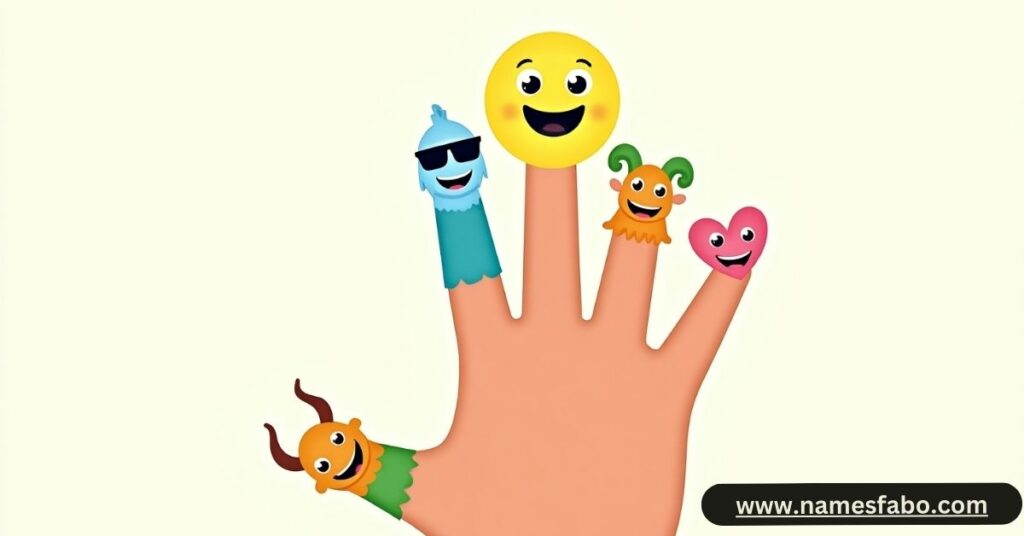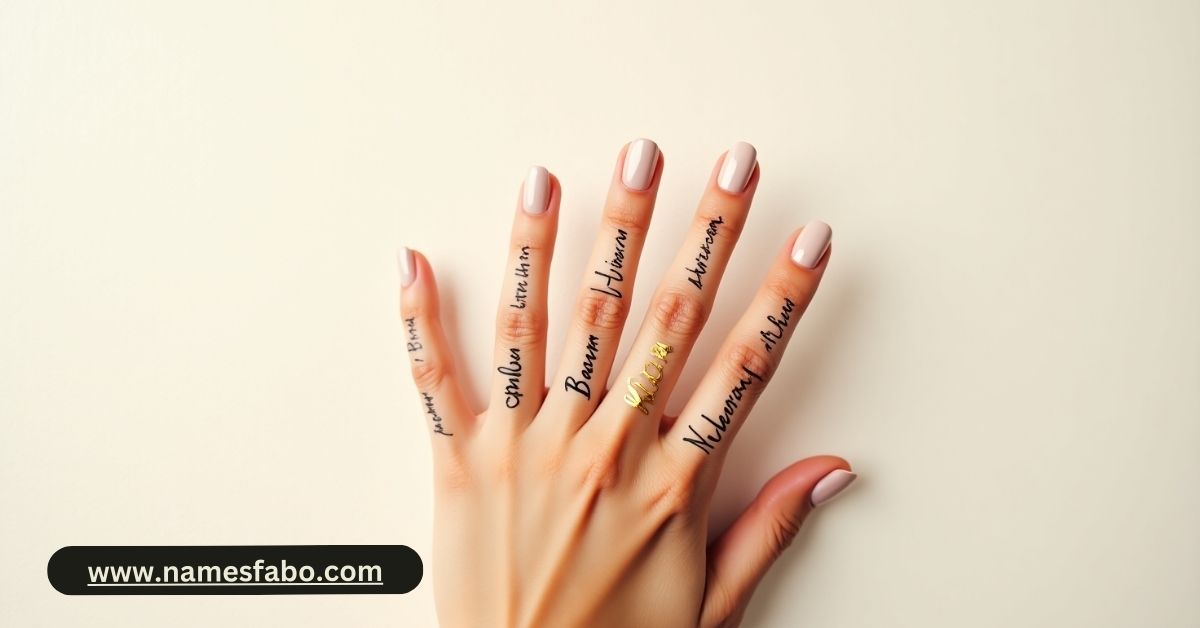Ever wondered why we call them the thumb, pinky, or index finger and what else they could be called across cultures and creativity?
Most people never think twice about their fingers… until they need the perfect Finger Names for a project, a character, a game, or even a fun classroom activity.
But here’s the thing: your fingers hold more personality than you realize.
In this ultimate guide, we’ll dive deep into stylish, quirky, funny, and even culturally rich finger names that go way beyond the basics. Whether you’re naming for fun, function, or flair this list will make your digits unforgettable.
Where Do Finger Names Come From?
Ever wondered why we call our thumb a “thumb” and not something else? The history behind finger names is fascinating!
The naming of our fingers dates back thousands of years, with many names rooted in ancient languages and practical functions. The word “thumb,” for instance, comes from the Old English “þūma,” related to words meaning “swollen” or “thick” perfectly describing its sturdy appearance compared to other fingers!
Different cultures developed their own naming systems based on local languages, practical use, and even superstitions. Medieval Europeans often named fingers based on their perceived connection to planets and celestial bodies, a practice that influenced both medical thinking and fortune-telling traditions that still echo today.
Why Name Your Fingers?

Naming your fingers isn’t just a quirky hobby it serves several practical purposes that have shaped human communication and learning for centuries!
Giving distinct names to each finger helps us communicate more precisely about these vital appendages. Think about it when you injured your “ring finger” last week, everyone immediately knew which one you meant! From medical professionals describing procedures to parents teaching children about their bodies, specific finger names create clarity that general terms like “the fourth finger” simply can’t match.
Finger names also provide cultural touchpoints that connect us across generations. When grandparents play “This Little Piggy” with toddlers, they’re participating in a naming tradition that dates back hundreds of years. These playful finger names create bonds and help children develop language skills while learning about their bodies.
How the 5 Fingers Got Their Names
The familiar names we use today for our fingers have evolved through fascinating historical journeys spanning centuries and cultures.
The thumb earned its name from its distinctive thickness the Old English word “þūma” (thūma) literally references something thick or swollen. As our most opposable and distinctive digit, it naturally required a standout name! The index finger got its name from its pointing function “index” comes from Latin, meaning “to point” or “to indicate.” When you’re showing someone directions or emphasizing a point, this finger does the heavy lifting.
The middle finger’s name comes from its obvious position at the center of the hand, making it our longest digit. The ring finger earned its name from the ancient Roman and Greek belief that it contained a vein (the “vena amoris” or “love vein”) that connected directly to the heart, making it the perfect finger for wedding rings. And finally, our pinky got its name from the Dutch word “pink,” meaning “little finger” a perfect description of this smallest digit.
Funny, Cute, and Cool Finger Names

Want to get creative with what you call your digits? Here’s some inspiration that ranges from adorably cute to cleverly cool!
Baby Finger Names
- Tiny Tim
- Little Bean
- Wee Willie
- Baby Belle
- Mini Mia
- Teeny Tony
- Itsy Bitsy
- Micro Mike
- Petit Pete
- Bitty Boo
Cute Finger Names for Kids
- Thumbkin
- Pointer Pal
- Tall Toby
- Ring Rosie
- Pinky Promise
- Thumbelina
- Captain Point
- Middleton
- Goldie (for ring finger)
- Tiny Twinkle
Funny Finger Nicknames
- The Boss (thumb)
- Nosy Parker (index)
- Sky Scraper (middle)
- Bling Holder (ring)
- Pinky Swear
- The Hitchhiker
- Mr. Rude (middle finger)
- The Selector (index)
- The Accessorizer (ring)
- The Earwax Explorer (pinky)
Finger Names for Puppets or Drawings
- Thumber
- Inspector Index
- Major Middle
- Sir Rings-a-lot
- Princess Pinky
- Mr. Thumbs
- Detective Pointer
- Tall Paul
- Jewel
- Tiny Tim
Traditional Finger Names and Meanings
Beyond the common names we use today, fingers have carried rich symbolic meanings across different traditions and time periods.
In medieval Europe, fingers were associated with planets and celestial qualities: the thumb represented Venus and love; the index finger symbolized Jupiter and authority; the middle finger was linked to Saturn and fate; the ring finger connected to the Sun and creativity; while the pinky related to Mercury and communication. These connections influenced everything from medicine to astrology.
Many cultures developed specific terms within their professional communities. Musicians refer to fingers by numbers (1-5), with different numbering systems for string players versus pianists. Jewelers have specialized names related to ring sizing, while sailors developed specific terms for fingers based on their roles in handling ropes and navigating.
Finger Names for Characters or Stories
Creating finger puppet shows or writing children’s stories? These character-ready finger names might spark your imagination!
- Thumbkin the Brave
- Inspector Pointer
- Mighty Middle
- Ringo the Wise
- Pinky the Explorer
- Captain Thumbsup
- Indy the Adventurer
- Max the Tall
- Goldie Rings
- Tiny the Curious
These character names give each finger distinctive personalities that can help children remember their names while encouraging creative play. Many storytellers create finger families where each digit has its own role the thumb as the father, the index as the mother, and so on creating ready-made characters for interactive storytelling.
Naming Fingers for Educational Purposes

Teachers and parents have developed clever systems to help children learn and remember finger names through engaging activities.
One popular technique uses rhyming associations: “Tommy Thumb,” “Peter Pointer,” “Toby Tall,” “Ruby Ring,” and “Pinky Small” create memorable connections that stick in young minds. These playful names often appear in children’s songs and finger play activities that combine movement with naming practice.
Some educators use occupation-themed names to highlight each finger’s function: “Builder Thumb” emphasizes its strength, “Teacher Pointer” showcases its indicating ability, “Lookout Tall” references its height, “Doctor Ring” connects to its traditional association with healing, and “Little Helper” acknowledges how the pinky assists with fine motor tasks.
Finger Nicknames Across Social Media
Social media has given rise to new finger-naming trends as people share hand gestures, nail art, and finger-focused content online!
Hashtags like #ThumbGang and #PinkyUp have created communities around specific finger identities, while TikTok trends feature creators giving their fingers personalities and voices. Nail artists often name designs based on which finger they adorn “statement ring finger” and “accent pinky” have become common terms in beauty communities.
Emoji culture has also influenced finger naming, with the thumbs-up 👍 and peace sign ✌️ creating shorthand references to specific fingers. Some influencers have even built personal brands around finger-related content, from hand models to ASL interpreters who highlight the expressive potential of our digits.
Finger Name in English
The standard English names for our five fingers have become widely recognized, even as regional variations persist.
The five established English finger names are:
- Thumb
- Index finger (also called forefinger or pointer finger)
- Middle finger
- Ring finger
- Little finger (also called pinky)
While these names dominate formal communication, English dialects around the world preserve regional variations. In parts of Scotland, the pinky might be called the “pinkie,” while some American dialects preserve older terms like “fourth finger” instead of “ring finger.” Medical professionals sometimes use ordinal numbering (first through fifth digits), with the thumb counted as the first.
Read More : 200+ Best Sibling Group Names for Friends: Funny, Cute, and Cool Chat Name Ideas
Hand Finger Name
The complete hand includes more than just the fingers understanding the full anatomy helps put finger names in context.
Your hand consists of your palm (the central part), your wrist (the connecting joint to your arm), and your five digits. Each finger has its own structure: three phalanges (bones) in every finger except the thumb, which has two. The joints connecting these bones have their own names too from the metacarpophalangeal joint (where fingers meet the palm) to the distal interphalangeal joint near the fingertip.
When medical professionals discuss hand anatomy, they use directional terms that might sound unfamiliar: “distal” refers to areas furthest from the body center (fingertips), while “proximal” indicates parts closer to the body center (where fingers join the palm). Understanding these terms helps make sense of medical discussions about finger injuries or conditions.
Toe vs Finger Names: What’s the Difference?
Toe Names and Finger Names show us how different parts of our body serve different jobs. Fingers help us grab and feel things, so they got special names like thumb, index, middle, ring, and pinky based on what they do. Toes mainly help us balance and walk, so their names focus more on size, like big toe and little toe. Finger Names vary across cultures, with Japanese people calling the thumb a “parent finger” and Chinese people naming the index finger the “food finger.”
Learn more about Toe Names and Finger Names to understand your amazing body better! Try pointing to each finger and toe while saying its name out loud. This helps you remember their names and appreciate how special each digit truly is. Your fingers and toes work together to help you explore the world!
Anatomical Overview
Both fingers and toes are terminal digits on our limbs, but they’ve evolved for very different purposes. Fingers developed for manipulation, grasping, and fine motor skills, leading to greater length differentiation and flexibility. Toes evolved primarily for balance and locomotion, resulting in a more uniform size pattern (except for the big toe) and less independent movement.
The most striking structural difference is the opposable thumb a feature that distinguishes human hands from feet and gave rise to the thumb’s special naming status across cultures. While both appendages have similar bone structures (phalanges), the proportions and joint mobility differ substantially.
Fingers
Finger names highlight their functional roles in human activities. The index finger’s name focuses on its pointing function; the ring finger is named for its cultural role in wearing jewelry; the middle finger is defined by its position; the thumb by its distinctive shape; and the pinky by its small size.
English finger naming emphasizes both function and position, while some languages like Japanese use numerical positions exclusively (thumb = first finger, index = second finger, etc.). This reflects cultural differences in how we conceptualize and interact with our hands.
Toes
Toe names are typically more straightforward and less culturally elaborate than finger names. We commonly refer to:
- Big toe (hallux)
- Second toe
- Middle toe
- Fourth toe
- Little toe (pinky toe)
Unlike fingers, toe naming focuses primarily on size and position rather than function, reflecting their more limited role in daily activities. The big toe receives the most attention because of its crucial role in balance and walking, while the others are often grouped together in common reference.
Read More About : 230+ Funny Inappropriate Names That Will Leave You Laughing Out Loud
Toes Fingers Name Across Cultures
Different societies have developed unique ways of naming and categorizing fingers based on their cultural values, languages, and traditions.
Japanese Culture
Japanese finger naming follows a numerical system that counts from the thumb:
- Oyayubi (親指) – “parent finger” (thumb)
- Hitosashiyubi (人差し指) – “person-pointing finger” (index)
- Nakayubi (中指) – “middle finger”
- Kusuriyubi (薬指) – “medicine finger” (ring finger)
- Koyubi (小指) – “small finger” (pinky)
This system beautifully reflects Japanese cultural values naming the thumb as the “parent finger” emphasizes family hierarchy, while calling the ring finger the “medicine finger” connects to traditional healing practices where this finger was used to apply medicinal compounds.
Chinese Culture
Chinese finger names combine numerical ordering with functional descriptions:
- 大拇指 (dà mǔ zhǐ) – “big thumb”
- 食指 (shí zhǐ) – “food finger” (used for eating)
- 中指 (zhōng zhǐ) – “middle finger”
- 无名指 (wú míng zhǐ) – “nameless finger” (ring finger)
- 小指 (xiǎo zhǐ) – “small finger”
The Chinese designation of the ring finger as the “nameless finger” offers an interesting contrast to Western traditions that give this digit special significance. Meanwhile, calling the index finger the “food finger” highlights cultural eating practices where this finger traditionally played an important role.
Scientific and Medical Research
Modern science has deepened our understanding of these remarkable appendages that inspired such varied naming traditions throughout human history.
Evolutionary Perspective
From an evolutionary standpoint, our fingers represent one of humanity’s greatest adaptations. The opposable thumb set apart from other primates by its exceptional range of motion enabled tool use that transformed human development. Scientists believe the specialized finger structure evolved over millions of years, with precision grip capabilities appearing around 2-3 million years ago.
This evolutionary journey shaped finger naming: the distinctive functions that emerged (pointing, grasping, fine manipulation) influenced how cultures identified and categorized these digits. As humans developed more sophisticated tools and crafts, finger specialization increased, reinforcing naming distinctions.
Medical Research
Medical researchers use standardized anatomical terms for fingers that differ from everyday names. Officially, fingers are “digits” numbered 1-5, with the thumb as digit 1. This systematic approach helps ensure precision in medical literature and practice across language barriers.
Recent research has revealed fascinating differences between fingers from varying fingerprint patterns to the different nerve distributions that give each finger its unique sensitivity profile. These biological distinctions sometimes align with traditional naming intuitions: the ring finger, for instance, does have unique nerve pathways that differ from other digits.
Biomechanics
The study of finger biomechanics has revealed why certain fingers earned their names and roles. The thumb’s opposable design creates a mechanical advantage that justifies its status as our most important digit. The index finger’s direct connection to specific motor cortex regions explains its pointing precision, while the middle finger’s central position provides maximal leverage.
Understanding these biomechanical properties helps explain why certain naming conventions emerged consistently across cultures the physical realities of finger function shaped how humans conceptualized these appendages, regardless of language or cultural background.
Read More : 400+ Cute Usernames for Girls [Social Media and Gaming] 2025
FAQ’s
What is the medical name for each finger?
Medically, fingers are referred to as digits with specific anatomical names:
- Pollex (thumb)
- Index digit (second digit)
- Middle digit (third digit)
- Ring digit (fourth digit)
- Minimus digit (fifth digit or little finger)
These Latin-derived terms provide standardized language for medical professionals worldwide, enabling precise communication across language barriers when discussing finger conditions or procedures.
What do doctors call each finger?
When communicating with patients, doctors typically use common finger names (thumb, index, middle, ring, little finger) for clarity. In medical documentation, they often employ a numbering system where digits are numbered 1-5 (with the thumb as 1) combined with directional terms like “distal” (toward fingertip) and “proximal” (toward palm).
For specific structures, doctors use anatomical terminology: “distal phalanx” for the bone at the fingertip, “proximal interphalangeal joint” for the middle knuckle, etc. When discussing hand injuries with colleagues, they might refer to “D2” (digit 2) rather than “index finger” for conciseness.
What are the names of the 5 fingers?
The standard English names for the five fingers are:
- Thumb
- Index finger (also called forefinger or pointer finger)
- Middle finger
- Ring finger
- Little finger (commonly called pinky)
These names have remained remarkably stable in English for centuries, though regional variations exist. The term “pinky,” for instance, gained popularity in American English during the 19th century from Dutch influence, while British English traditionally preferred “little finger.”
How to label fingers medically?
Medical labeling of fingers follows specific conventions:
- Digits are numbered 1-5, starting with the thumb
- Directions are specified using terms like distal (toward fingertip), proximal (toward palm), dorsal (back of hand), and palmar (palm side)
- Bones are identified as phalanges (singular: phalanx) with designations like “proximal phalanx of digit 3”
- Joints are named according to the bones they connect, such as “metacarpophalangeal joint of digit 2”
This systematic approach ensures consistency in medical records and communication, regardless of the healthcare provider’s native language or cultural background.
What are some funny names for fingers?
Humorous finger nicknames have emerged in popular culture:
- “Thumbkin” or “Mr. Strong” for the thumb
- “Nosy Parker” or “The Accuser” for the index finger
- “Mick the Middle” or “The Rude One” for the middle finger
- “Bling Holder” or “Promise Keeper” for the ring finger
- “Pinky Swear” or “Earwax Explorer” for the little finger
These playful names often highlight the stereotypical functions or characteristics of each digit, creating memorable associations that persist in childhood games and casual references.
Can I name my fingers?
Absolutely! Many people create personal names for their fingers for fun, to help children learn finger names, or as creative expression. There’s no rule against giving your digits personalized names like “Thomas Thumb” or “Isabelle Index.”
Naming your fingers can actually help with coordination and therapy after injuries. Some occupational therapists encourage patients to name their fingers to facilitate exercises and create positive associations during recovery. Musicians, typists, and others who rely heavily on finger dexterity sometimes develop personal naming systems that help them conceptualize movements.
What is the meaning behind finger names?
Traditional finger names carry rich symbolic associations:
- The thumb represents willpower and identity in many cultures
- The index finger symbolizes authority and direction
- The middle finger has associations with balance and sometimes defiance
- The ring finger connects to commitment and creativity
- The little finger relates to communication and intuition
These meanings evolved from both practical functions and cultural beliefs about each finger’s significance. In palmistry traditions, each finger corresponds to different planetary influences and personality traits, creating another layer of symbolic meaning that has influenced finger naming across cultures.
Conclusion
Finger Names connect us to history, culture, and practical daily life. Your fingers have special names like thumb, index, middle, ring, and pinky because people from long ago needed ways to talk about these important body parts. Every culture created their own Finger Names based on what each finger does best. You can have fun with Finger Names too! Create your own funny names for puppet shows, or learn the proper names to sound smart at school. Remember all five Finger Names to impress your friends and family with your knowledge.
Want to learn more about your amazing hands? Explore our website for fun finger facts and activities that will make you a hand expert! Try our finger-naming game with friends or ask your parents about finger names in your family’s culture. Your fingers help you do almost everything from writing and eating to playing games so knowing their names is just the beginning of understanding how special your hands truly are!

Lena Rivers
Content Creator
Lena Rivers, our co-founder and creative soul, combines her love for animals with a flair for fantasy naming. Her unique ability to blend myth and nature results in captivating names that bring magical creatures to life. With a passion for storytelling, Lena adds a touch of wonder to every project she undertakes.

